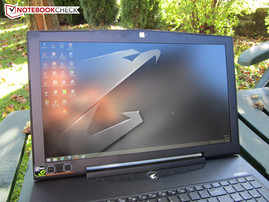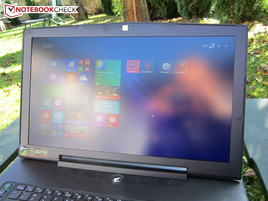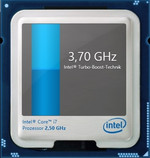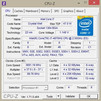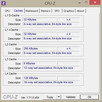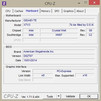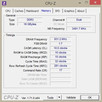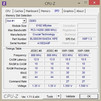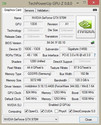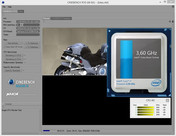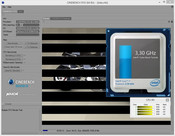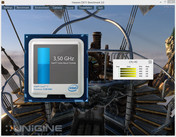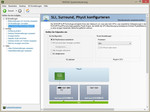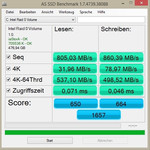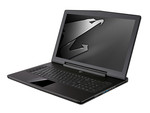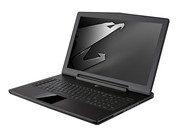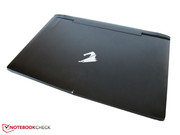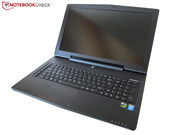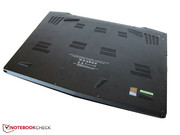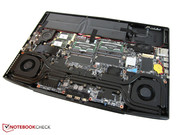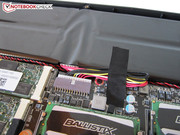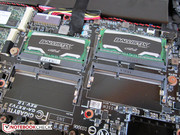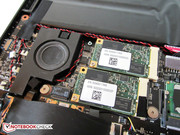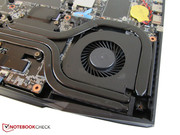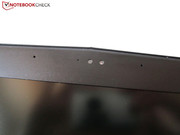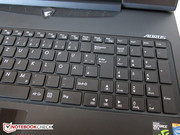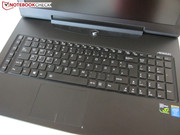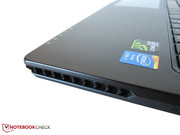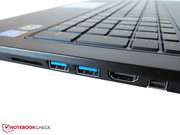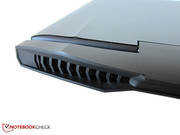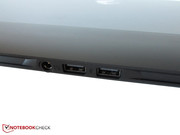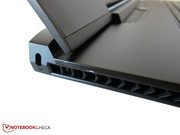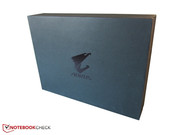Aorus X7 Pro Notebook Review
For the original German review, see here.
Gigabyte's gaming brand Aorus has specialized on high-end laptops with dual-graphics power. While the first X7 featured the GeForce GTX 765M SLI, an SLI array of two GTX 860Ms operated in the X7 v2. The third model dubbed X7 Pro ultimately takes the performance cake. The Maxwell architecture makes it possible for the manufacturer to install a pair of GeForce GTX 970Ms.
The other specs are also impressive. Our review sample sports 16 GB of DDR3 RAM (2x 8 GB @ 1866 MHz) and two 256 GB mSATA SSDs in a RAID 0 mode. The Core i7-4870HQ is not bad either considering its 2.5 - 3.7 GHz clock. The laptop's screen is traditional: A matte Full HD screen with 1920x1080 pixels is found in most devices. The buyer will not find an optical drive.
Since the chassis is identical with that of the first edition, this article omits the usual sections about casing, connectivity, and input devices. Apart from the components, the manufacturer has only modified the position and length of the heat pipes. The software has also been optimized. The comprehensive "Command & Control Center" (see screenshots) offers a few nifty innovations, such as the monitoring tool "System Gauge" or the fan manager "Fan Control" (now four rather than three settings).
Display
Although the precursor's screen made a feasible impression, a different screen is installed in the X7 Pro. The average brightness of 283 cd/m² of the AU Optronics B173HW01 V5 is a bit higher than that of the B173HW02 V1 in the X7 v2. The brightness distribution is roughly 82-83%.
| |||||||||||||||||||||||||
Brightness Distribution: 82 %
Center on Battery: 318 cd/m²
Contrast: 589:1 (Black: 0.54 cd/m²)
ΔE ColorChecker Calman: 3.79 | ∀{0.5-29.43 Ø4.79}
ΔE Greyscale Calman: 2.35 | ∀{0.09-98 Ø5}
58% AdobeRGB 1998 (Argyll 1.6.3 3D)
64.9% AdobeRGB 1998 (Argyll 3D)
88.7% sRGB (Argyll 3D)
67.9% Display P3 (Argyll 3D)
Gamma: 2.37
CCT: 6775 K
No significant differences are found in the black level either. 0.54 cd/m² is neither good nor bad and stands for a mediocre black that looks a bit grayish in dark game and video scenes. All this leads to a contrast of approximately 590:1, which should suffice for the expectations of most buyers.
Although the rate would have to be higher for a really crisp black, higher-contrast screens, like the Chi Mei N173HGE, struggle with other shortcomings. For example, stripes do not evolve in the B173HW01 V5 (e.g. MSI's GT72 or Schenker's XMG P724) and the image does not look grainy. The only annoying thing that is noticed when looking closer is the visible pixel grid.
The screen is beyond reproach otherwise. Owing to a preloaded color profile, which is, unfortunately, not active in every application, Aorus masks the notebook-typical bluish cast in a simple way. According to our CalMAN assessments, the X7 Pro offers a quite good color balance that is especially noticed when compared directly with the Chi Mei N173HGE. We ascertained a 79% coverage of sRGB and 58% coverage of AdobeRGB.
The non-reflective surface allows using the screen well outdoors. However, the viewing-angle stability is only enough for a place in the midfield. The AU Optronics screen does not stand a chance against a high-quality IPS screen. Distortions turn up quite soon when looking up from the sides - as is common in the TN sector.
Performance
Processor
The choice of the processor surprised us the most. Despite the fact that the X7 Pro does not feature graphics switching, Aorus installs a quad-core model based on the Iris Pro Graphics 5200. The latter might be considerably stronger than the HD Graphics 4600 from the "standard" Haswell chips, but what good is the extra effort when the Iris Pro 5200 cannot be utilized?
In the writer's opinion, Aorus should have saved its money and installed a standard quad-core instead. Especially since the Core i7-4870HQ cannot retrieve its full power. The premium-line model more follows the Core i7-4710HQ with its 6 MB of L3 cache, TDP of 47 watts, and a base clock of 2.5 GHz.
Turbo Boost
As said above, the Core i7-4870HQ can only develop its potential to a certain degree. Although the 22 nm chip achieves 3.5 - 3.7 GHz in single-core applications, it is only 3.2 - 3.3 rather than the theoretically possible 3.5 GHz in multi-core applications. Consequently, it is no surprise that the performance settles on the level of the considerably less expensive Core i7-4700HQ (2.4 - 3.4 GHz).
CPU Performance
The limited Turbo is seen in the multi-core rendering of Cinebench R15 among other things. While Schenker's XMG P505 with the same processor in the test reaped in 709 points, the Aorus X7 Pro only managed 621 points, which is roughly 12% less. Even the Core i7-4710HQ in the X7 v2 achieved a higher score (659 points). The speed is more than decent in the single-core CPU test. 143 points is very similar to the score of the XMG P505. A Core i7-4710HQ usually has to be satisfied with approximately 135 points here (MSI GT72 2QE).
| Cinebench R15 | |
| CPU Single 64Bit (sort by value) | |
| Aorus X7 Pro | |
| Aorus X7 v2 | |
| MSI GT72-2QE32SR311BW | |
| Schenker XMG P724 | |
| Schenker XMG P505 | |
| CPU Multi 64Bit (sort by value) | |
| Aorus X7 Pro | |
| Aorus X7 v2 | |
| MSI GT72-2QE32SR311BW | |
| Schenker XMG P724 | |
| Schenker XMG P505 | |
| Cinebench R11.5 | |
| CPU Single 64Bit (sort by value) | |
| Aorus X7 Pro | |
| Aorus X7 v2 | |
| MSI GT72-2QE32SR311BW | |
| Schenker XMG P724 | |
| Schenker XMG P505 | |
| CPU Multi 64Bit (sort by value) | |
| Aorus X7 Pro | |
| Aorus X7 v2 | |
| MSI GT72-2QE32SR311BW | |
| Schenker XMG P724 | |
| Schenker XMG P505 | |
Graphics Card
The X7's biggest leap is in graphics power. Unlike the v2 that was still powered by the GTX 860M SLI, a dual-GPU array of two GTX 970M chips takes care of pending calculations.
The GTX 970M's enormous performance boost is not only due to the bigger shader count (1280 vs. 1152 CUDA cores) and the higher core clock (924 - 1038 vs. 797 - 915 MHz), but it is primarily owed to the architecture. Nvidia's new premium-line product is now based on Maxwell rather than Kepler, which is not lastly noticed in waste heat and power consumption. Although the GTX 860M also exists in a Maxwell version, it is reserved for single-GPU laptops.
Almost no drawbacks connected to the fact that Aorus only uses 3 GB of GDDR5 VRAM with the GTX 970M (MSI installs the 6 GB model in the GT72). Only Shadow of Mordor craves for more than 3 GB at the moment - at least in the Ultra level. But disregarding the memory capacity, the interface is 192-bit in each case.
Though we often made snide remarks about dual-GPU laptops in the past, the situation now looks better. Of course, the power consumption is very high due to the lack of graphics switching, and naturally micro-stutters occur in some games, depending on the settings.
However, Nvidia has such a good driver support that it is possible to disregard existing shortcomings to an extent. Except for FIFA 15 and Risen 3, all tested games benefited from the second graphics chip. Sometimes it was only a few fps (+ 12% @ Sims 4), but it was 40 - 90% in most cases. We ascertained almost no graphics errors or other bugs that are usually related to SLI. Only these three titles did not run quite smoothly:
- Watch Dogs stuttered in high and maximum settings - as frequently observed - very strongly. The brightness was too high in the low and medium levels.
- Ryse: Son of Rome also tended to stutter in (very) high graphics settings.
- Risen 3 once again behaved very strangely in terms of performance (not over 40 fps).
Despite the laudable overall presentation, we would recommend a single GPU. Neither the price-performance ratio nor the "user comfort" (temperature, etc.) speak for an SLI laptop.
GPU Performance
The SLI advantage is traditionally the biggest in the synthetic graphics benchmarks, for example in the Fire Strike test of 3DMark 13. Owing to the slightly updated driver (we replaced the preloaded ForceWare 344.00 with the ForceWare 344.48), the Aorus X7 Pro calculated twice as fast as Schenker's XMG P505 that has to be satisfied with a single GTX 970M. A GPU score of 14873 points is worthy of reference and outclasses the performance level of the GTX 980M by almost 50% (9808 points @ MSI GT72 2QE). The Maxwell array is even 2.5 times faster than the GTX 860M SLI (5941 points @ X7 v2). Only the GTX 880M SLI is a threat for the in-house contenders (11926 points @ Schenker XMG P724).
| 3DMark Vantage P Result | 35318 points | |
| 3DMark 11 Performance | 14203 points | |
| 3DMark Ice Storm Standard Score | 142928 points | |
| 3DMark Cloud Gate Standard Score | 23191 points | |
| 3DMark Fire Strike Score | 10621 points | |
Help | ||
| Unigine Heaven 3.0 - 1920x1080 DX 11, Normal Tessellation, High Shaders AA:Off AF:Off (sort by value) | |
| Aorus X7 Pro | |
| Aorus X7 v2 | |
| Schenker XMG P724 | |
| Schenker XMG P505 | |
| MSI GT72-2QE32SR311BW | |
| 3DMark - 1920x1080 Fire Strike Graphics (sort by value) | |
| Aorus X7 Pro | |
| Aorus X7 v2 | |
| Schenker XMG P724 | |
| Schenker XMG P505 | |
| MSI GT72-2QE32SR311BW | |
| 3DMark 11 - 1280x720 Performance GPU (sort by value) | |
| Aorus X7 Pro | |
| Aorus X7 v2 | |
| Schenker XMG P724 | |
| Schenker XMG P505 | |
| MSI GT72-2QE32SR311BW | |
| 3DMark Vantage - 1280x1024 P GPU no PhysX (sort by value) | |
| Aorus X7 Pro | |
| Aorus X7 v2 | |
| Schenker XMG P724 | |
| Schenker XMG P505 | |
| MSI GT72-2QE32SR311BW | |
Storage Devices
The sense or nonsense of a RAID array is a fabulous reason for debate. On the one hand, RAID laptops stand out with excellent rates in the sequential tests. Up to 805 MB/s in read and a maximum of 860 MB/s in write (AS SSD benchmark) are otherwise only achieved by an M.2 model connected via PCI3 (Schenker XMG P505). Solid state drives with a SATA III interface stop at about 500 MB/s.
But on the other hand, this advantage is barely noticed in Windows routine (boot times, load times, installations, etc.) because the performance in compact files is more important here. That is exactly where RAID systems are not inevitably faster. Consequently, a "conventional" solid state drive would have been just as sufficient for the X7 Pro. The laptop can be equipped with three mSATA SSDs and a 2.5-inch model when desired.
System Performance
PCMark 7 recorded an excellent total performance for the X7 Pro. With 6141 points, the 17-inch scion ranges on the level of MSI's GS60 and GS70 rivals that - depending on the model - also feature a RAID system.
| PCMark 7 Score | 6141 points | |
| PCMark 8 Home Score Accelerated v2 | 4841 points | |
| PCMark 8 Creative Score Accelerated v2 | 5542 points | |
| PCMark 8 Work Score Accelerated v2 | 5130 points | |
Help | ||
Gaming Performance
There is no doubt that the GTX 970M SLI is a first-rate partner for gaming enthusiasts. No matter whether it is Battlefield 4, Crysis 3, Metro: Last Light or Far Cry 3 - every demanding title that has been released in the past few years can be enjoyed in maximum details and with enabled anti-aliasing. The system would calculate about 30% slower with disabled SLI. Since the SLI array can surpass a GTX 980M by only 20%, we believe that the additional risk (driver dependency) and the additional costs (power requirement, laptop price) are not justified. Not even if the X7 Pro outruns its precursor by almost 100% (+25% vs. GTX 880M SLI).
| Civilization: Beyond Earth - 1920x1080 Ultra Preset AA:4x MS (sort by value) | |
| GeForce GTX 970M SLI (344.48) | |
| GeForce GTX 980M (344.00) | |
| F1 2014 - 1920x1080 Ultra Preset AA:4x MS (sort by value) | |
| GeForce GTX 970M SLI (344.48) | |
| GeForce GTX 980M (344.00) | |
| The Evil Within - 1920x1080 High / Enabled AA:SM (sort by value) | |
| GeForce GTX 970M SLI (344.48) | |
| GeForce GTX 980M (344.00) | |
| Ryse: Son of Rome - 1920x1080 Very High Texture Res. + High Graphics Quality (Motion Blur & Temporal AA On, Rest Off/Disabled) AF:8x (sort by value) | |
| GeForce GTX 970M SLI (344.48) | |
| GeForce GTX 970M (344.00) | |
| GeForce GTX 980M (344.00) | |
| Alien: Isolation - 1920x1080 Ultra, On, Shadow Map 2048, HDAO AA:2x SM AF:16x (sort by value) | |
| GeForce GTX 970M SLI (344.48) | |
| GeForce GTX 970M (344.00) | |
| GeForce GTX 980M (344.00) | |
| Middle-earth: Shadow of Mordor - 1920x1080 Ultra Preset (HD Package) (sort by value) | |
| GeForce GTX 970M SLI (344.48) | |
| GeForce GTX 970M (344.00) | |
| GeForce GTX 980M (344.00) | |
| Fifa 15 - 1920x1080 High Preset AA:4x MS (sort by value) | |
| GeForce GTX 970M SLI (344.48) | |
| GeForce GTX 970M (344.00) | |
| GeForce GTX 980M (344.00) | |
| Sims 4 - 1920x1080 Ultra Preset (sort by value) | |
| GeForce GTX 970M SLI (344.48) | |
| GeForce GTX 970M (344.00) | |
| GeForce GTX 980M (344.00) | |
| Risen 3: Titan Lords - 1920x1080 Ultra/High, On AF:16x (sort by value) | |
| GeForce GTX 970M SLI (344.48) | |
| GeForce GTX 970M (344.00) | |
| GeForce GTX 980M (344.00) | |
| GRID: Autosport - 1920x1080 Ultra Preset AA:4x MS (sort by value) | |
| GeForce GTX 970M SLI (344.48) | |
| GeForce GTX 860M SLI (333.11) | |
| GeForce GTX 970M (344.00) | |
| GeForce GTX 980M (344.00) | |
| Watch Dogs - 1920x1080 Ultra Overall Quality, Ultra Textures AA:4x MS (sort by value) | |
| GeForce GTX 970M SLI (344.48) | |
| GeForce GTX 860M SLI (333.11) | |
| GeForce GTX 970M (344.00) | |
| GeForce GTX 980M (344.00) | |
| Wolfenstein: The New Order - 1920x1080 Ultra Preset (sort by value) | |
| GeForce GTX 970M SLI (344.48) | |
| GeForce GTX 860M SLI (333.11) | |
| GeForce GTX 970M (344.00) | |
| GeForce GTX 980M (344.00) | |
| Thief - 1920x1080 Very High Preset AA:FXAA & High SS AF:8x (sort by value) | |
| GeForce GTX 970M SLI (344.48) | |
| GeForce GTX 860M SLI (333.11) | |
| GeForce GTX 880M SLI (332.35) | |
| GeForce GTX 970M (344.00) | |
| GeForce GTX 980M (344.00) | |
| Call of Duty: Ghosts - 1920x1080 Extra / High / HBAO+ / No dynamic fur AA:4x MS (sort by value) | |
| GeForce GTX 970M SLI (344.48) | |
| GeForce GTX 860M SLI (333.11) | |
| GeForce GTX 880M SLI (332.35) | |
| GeForce GTX 970M (344.00) | |
| GeForce GTX 980M (344.00) | |
| Battlefield 4 - 1920x1080 Ultra Preset AA:4x MS (sort by value) | |
| GeForce GTX 970M SLI (344.48) | |
| GeForce GTX 860M SLI (333.11) | |
| GeForce GTX 880M SLI (332.35) | |
| GeForce GTX 970M (344.00) | |
| GeForce GTX 980M (344.00) | |
| Saints Row IV - 1920x1080 Ultra Preset AA:8x MS AF:16x (sort by value) | |
| GeForce GTX 970M SLI (344.48) | |
| GeForce GTX 860M SLI (333.11) | |
| GeForce GTX 880M SLI (332.35) | |
| GeForce GTX 970M (344.00) | |
| GeForce GTX 980M (344.00) | |
| Dota 2 - 1920x1080 High / On, Render Quality: 100 % (sort by value) | |
| GeForce GTX 970M SLI (344.48) | |
| GeForce GTX 860M SLI (333.11) | |
| GeForce GTX 880M SLI (332.35) | |
| GeForce GTX 980M (344.00) | |
| Metro: Last Light - 1920x1080 Very High (DX11) AF:16x (sort by value) | |
| GeForce GTX 970M SLI (344.48) | |
| GeForce GTX 860M SLI (333.11) | |
| GeForce GTX 880M SLI (332.35) | |
| GeForce GTX 970M (344.00) | |
| GeForce GTX 980M (344.00) | |
| BioShock Infinite - 1920x1080 Ultra Preset, DX11 (DDOF) (sort by value) | |
| GeForce GTX 970M SLI (344.48) | |
| GeForce GTX 860M SLI (333.11) | |
| GeForce GTX 880M SLI (332.35) | |
| GeForce GTX 970M (344.00) | |
| GeForce GTX 980M (344.00) | |
| Tomb Raider - 1920x1080 Ultra Preset AA:FX AF:16x (sort by value) | |
| GeForce GTX 970M SLI (344.48) | |
| GeForce GTX 860M SLI (333.11) | |
| GeForce GTX 880M SLI (332.35) | |
| GeForce GTX 970M (344.00) | |
| GeForce GTX 980M (344.00) | |
| Crysis 3 - 1920x1080 Very High Preset AA:2xSM AF:16x (sort by value) | |
| GeForce GTX 970M SLI (344.48) | |
| GeForce GTX 860M SLI (333.11) | |
| GeForce GTX 880M SLI (332.35) | |
| GeForce GTX 970M (344.00) | |
| GeForce GTX 980M (344.00) | |
| Far Cry 3 - 1920x1080 DX11 Ultra Preset (HDAO, Enhanced Alpha To Coverage) AA:4x MS (sort by value) | |
| GeForce GTX 970M SLI (344.48) | |
| GeForce GTX 860M SLI (333.11) | |
| GeForce GTX 880M SLI (332.35) | |
| GeForce GTX 970M (344.00) | |
| GeForce GTX 980M (344.00) | |
| Hitman: Absolution - 1920x1080 Ultra Preset AA:4xMS AF:16x (sort by value) | |
| GeForce GTX 970M SLI (344.48) | |
| GeForce GTX 860M SLI (333.11) | |
| GeForce GTX 880M SLI (332.35) | |
| GeForce GTX 970M (344.00) | |
| GeForce GTX 980M (344.00) | |
| Guild Wars 2 - 1920x1080 All Maximum / On AA:FX (sort by value) | |
| GeForce GTX 970M SLI (344.48) | |
| GeForce GTX 860M SLI (333.11) | |
| GeForce GTX 880M SLI (332.35) | |
| GeForce GTX 970M (344.00) | |
| GeForce GTX 980M (344.00) | |
| low | med. | high | ultra | |
|---|---|---|---|---|
| Guild Wars 2 (2012) | 160.7 | 85.6 | 78.2 | |
| Hitman: Absolution (2012) | 113.1 | 108.3 | 99.3 | 76.2 |
| Far Cry 3 (2012) | 145.4 | 137.9 | 117.1 | 74.5 |
| Crysis 3 (2013) | 154.4 | 138.3 | 111.7 | 56.3 |
| Tomb Raider (2013) | 519 | 465.4 | 351.8 | 156.5 |
| BioShock Infinite (2013) | 290.2 | 273.1 | 233.7 | 130.1 |
| Metro: Last Light (2013) | 139.7 | 137 | 112.1 | 79.2 |
| Dota 2 (2013) | 119.7 | 119.7 | 119.4 | |
| Saints Row IV (2013) | 76.6 | 88.9 | 90.9 | 92.5 |
| Battlefield 4 (2013) | 199.6 | 199 | 196.6 | 104.3 |
| Call of Duty: Ghosts (2013) | 238.3 | 204.1 | 140.2 | 90.2 |
| Thief (2014) | 125.5 | 119.7 | 115.1 | 86.8 |
| Wolfenstein: The New Order (2014) | 60 | 60 | 60 | 55.7 |
| Watch Dogs (2014) | 103.6 | 89.4 | 63.9 | 45.5 |
| GRID: Autosport (2014) | 374.1 | 207.4 | 165.7 | 118.8 |
| Risen 3: Titan Lords (2014) | 35.2 | 35.2 | 35 | 37.6 |
| Sims 4 (2014) | 193.2 | 157.7 | 119.8 | 104.8 |
| Fifa 15 (2014) | 380.3 | 288.1 | 211.7 | |
| Middle-earth: Shadow of Mordor (2014) | 268.9 | 209.4 | 105.2 | 89.9 |
| Alien: Isolation (2014) | 264.9 | 237.9 | 153 | 114.1 |
| Ryse: Son of Rome (2014) | 63.6 | 62.9 | 61.6 | 61.1 |
| The Evil Within (2014) | 74.8 | 73.8 | 53.8 | |
| F1 2014 (2014) | 118 | 118 | 118 | 118 |
| Civilization: Beyond Earth (2014) | 159.4 | 150.9 | 115.2 | 104.6 |
Emissions
All following measurements were made with enabled SLI. While the fan setting "Auto Low Speed" was used in the idle tests, we used the setting "Auto High Speed" for the load tests. However, the latter does not seem worthwhile. Although the cooling system worked a bit harder, the performance did not increase (quick check using Unigine Heaven 3.0).
System Noise
Many buyers of the X7 Pro will find themselves thinking: "And just when you think that was the limit, a new fan level pops up somewhere." The 17-inch laptop belongs to one of the loudest devices that we have ever tested under load. 52 - 58 dB(A) in 3D mode will be too much for sensitive ears. The cooling is extremely present and almost sounds like a blow dryer even when using headphones or turned up speakers. We managed to provoke a very high rate from the X7 v2 at the time, but its maximum noise level was "only" 53 dB(A). However, we have to point out that almost all slim gaming laptops get loud, for example MSI's GS70 (~50 dB) or Gigabyte's P35W v2 (~54 dB).
The X7 Pro presents its quieter side in idle mode. The high-end scion is barely noticed when disregarding the fans' temporary speed increases (the fans sometime spin with 41 dB without reason). The cooling is even frequently inactive, making the X7 virtually noiseless. An indefinable, minor whistling can only be heard when listening closer. Nevertheless, the user should have a certain degree of noise resistance for the laptop. The soundtracks in gaming are often drowned out.
Noise level
| Idle |
| 29.5 / 32.1 / 41 dB(A) |
| Load |
| 52.3 / 57.9 dB(A) |
 | ||
30 dB silent 40 dB(A) audible 50 dB(A) loud |
||
min: | ||
Temperature
The temperature development is also unsurprisingly high. The laptop already heats up strongly during undemanding tasks because the fans are usually inactive in idle mode. Just below 40 °C after 120 minutes of idling is pretty high and almost corresponds to 100% of the former model. Users who like it cooler in Windows routine are better off with the competition (~28 °C @ MSI GS70; ~31 °C @ Schenker XMG P505).
Every thin gaming laptop gets hot under load. With a maximum of 61 °C, the Aorus X7 Pro is even a bit cooler than MSI's GS70 where we measured up to 63 °C in the fans' area. The XMG P505 finished the stress test (one hour of Furmark & Prime95) with a maximum of 76 °C. However, the wrist rest of Schenker's laptop is more pleasant.
The components also heat up considerably. Like in the X7 v2, the graphics chips climb to almost 90 °C. It looks quite the same when the processor is under full load. Despite the strong throttling, the Core i7-4870HQ reached about 90 °C.
(-) The maximum temperature on the upper side is 61.2 °C / 142 F, compared to the average of 40.5 °C / 105 F, ranging from 21.2 to 68.8 °C for the class Gaming.
(-) The bottom heats up to a maximum of 59.1 °C / 138 F, compared to the average of 43.2 °C / 110 F
(-) In idle usage, the average temperature for the upper side is 40.1 °C / 104 F, compared to the device average of 33.9 °C / 93 F.
(-) The palmrests and touchpad can get very hot to the touch with a maximum of 45.2 °C / 113.4 F.
(-) The average temperature of the palmrest area of similar devices was 28.9 °C / 84 F (-16.3 °C / -29.4 F).
Speakers
Information about the sound system can be found in the first edition review.
Energy Management
Power Consumption
The X7 Pro is not a device for energy-conscious users. 29 - 41 watts in idle remind us of the "Pre-Optimus Age" before graphics switching was invented. Even MSI's GT72 2QE that hunts for customers without Optimus technology does not guzzle that much power (24 - 34 watts).
Although the power requirement is quite high in 3D operation, the X7 Pro's average rate of 132 watts (first scene of 3DMark06) is a bit lower than that of the X7 v2 - despite the dual-graphics power. We look at the maximum consumption a bit critically. Just before CPU throttling, our measuring device recorded 276 watts (at the outlet, not including efficiency). That makes the fact that the laptop is only shipped with a 200-watt power supply all the more aggravating. 240 watts would have suited the X7 Pro better.
| Off / Standby | |
| Idle | |
| Load |
|
Key:
min: | |
Battery Runtime
The battery life is hardly worth mentioning. Even under ideal circumstances (low load, maximum energy saving, 0% screen brightness), the 73 Wh battery is drained after only three hours. 1.5 hours of 3D operation using a brightness of 100% is anything but lush. Considerably longer runtimes would be possible with graphics switching. Over five hours of gaming is no longer a wishful dream - at least not in idle mode.
Verdict
"Uncompromising" - that could summarize the X7 Pro in one word. To stand out from the competition, Aorus installs two premium-range chips in a high-quality, yet not particularly well-built 17-inch casing that can only deal with the enormous cooling requirement to a certain degree.
The slim build naturally looks quite good, but what good is that when the fans speed up to such an extent in gaming operation? Beyond 50 dB(A) is certainly not for users with a nervous disposition. Aorus also carries things to extremes in the other categories. Besides the battery life, it is primarily the temperature development that disappoints. The power consumption is also extreme. The unnecessary shortcomings, such as the sensitive touchpad or the power supply's tight capacity, add to that.
The brute power is, of course, on the pro side. No single-GPU laptop is currently a challenger for the X7 Pro. Three mSATA slots and a 2.5-centimeter thin aluminum chassis is not seen every day either. The bundle is rounded off by an illuminated keyboard (macro-hub) and nifty software.
Although the basic idea is quite interesting, we would wish for a thicker casing for the successor. The cooling seems a bit overloaded in the present design.
















